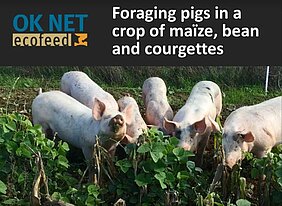In the OK-Net Ecofeed project, a trial began at his farm this autumn 2019. The aim is to provide a diverse range of mixed forage crops throughout the year and evaluate the interest of pig foraging in fattening/finishing. The expected results are to reduce the amount of concentrate feeding and improve the nutritional quality of carcasses.
Phase one of the trial consisted of laying out appropriate fences, organizing grazing stands, and test the conduct of a first batch of pigs. Their behavior was observed during this period to adapt the management protocol. The forage crop in place, well developed, was a "three sisters’ mix" of maize, haricot and courgettes. The squash has not developed due to competition with maïze and beans. The variety of bean (Rongaï) was too late, so the pods did not develop: this choice will be changed in 2020, probably “cow pea” or “haricot tarbais”. The maize suffered from the drought and stayed short, but it was homogeneous.
The farmer’s main fear was related to the distance of the plot, far away from the buildings (3-400 m). Circulation areas have been set up to facilitate the movement of pigs and to materialize the boundaries, consisting of permanent and electric fences. The level of concentrate has been reduced by 1/3 to encourage forage consumption. Pigs finally had no difficulty walking to the grazing area.
The group of 50 pigs rapidly entered in the forage. 2 plots of 0.5 ha each were grazed. To optimize the forage value, each plot was subdivided into 2, for a total of 4 paddocks. Pigs consume bean, and corn leaves and grain, but tend to leave the cob interior. The pigs proved to be extremely independent in establishing their own grazing routine without much prompting, finding their way to and from the buildings to the forage field. A small sub-group of 3 to 5 pigs adopted a different behavior, following their own routine.
After six weeks of grazing, the soil was preserved, and the vegetation was well-consumed. The batch of pigs was very heterogeneous, and growth rate was much lower than usual. There are two major explanations: 1) restricted feeding only partially compensated by forage, and 2) a heat wave followed by a very wet autumn. However, the muscle content of carcass was higher than the usual performance of the farm.
In conclusion, phase one of the trial is very hopeful. It seems important to adapt the feeding restriction according to the forage quality (analyses can help to take decisions), the season, and the growth rate of pigs, in particular the smallest ones.
The second phase of the trial, in spring 2020, will be centred around growth rates with regular weighing, and analysis of forage and meat quality. A continued exploration of optimal plant associations will be continued.
This article appeared on the OK-Net EcoFeed website in March 2020.
Further information
Video
Introducing maize, bean and courgettes into the diet of foraging pigs (OK-Net EcoFeed Video)
Link
ok-net-ecofeed.eu: Original article
